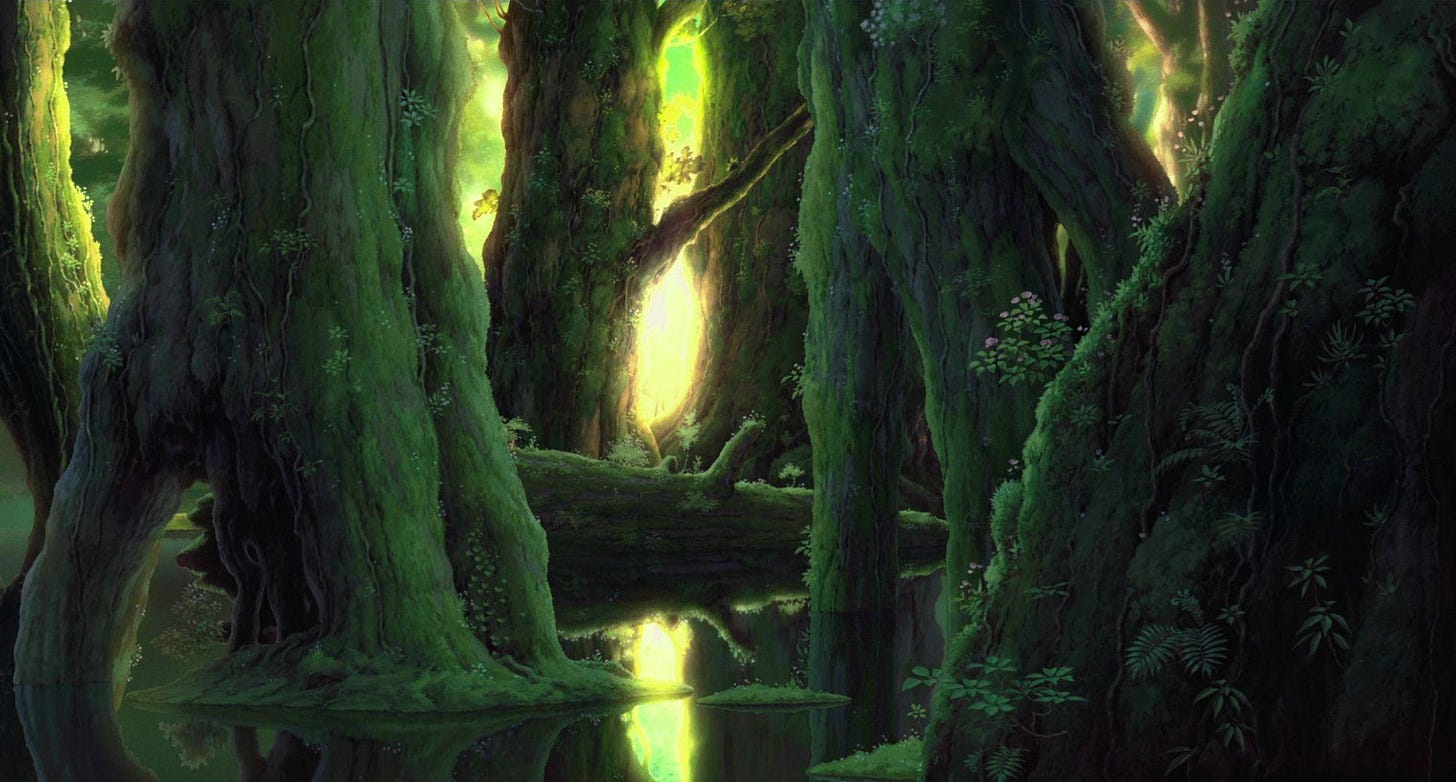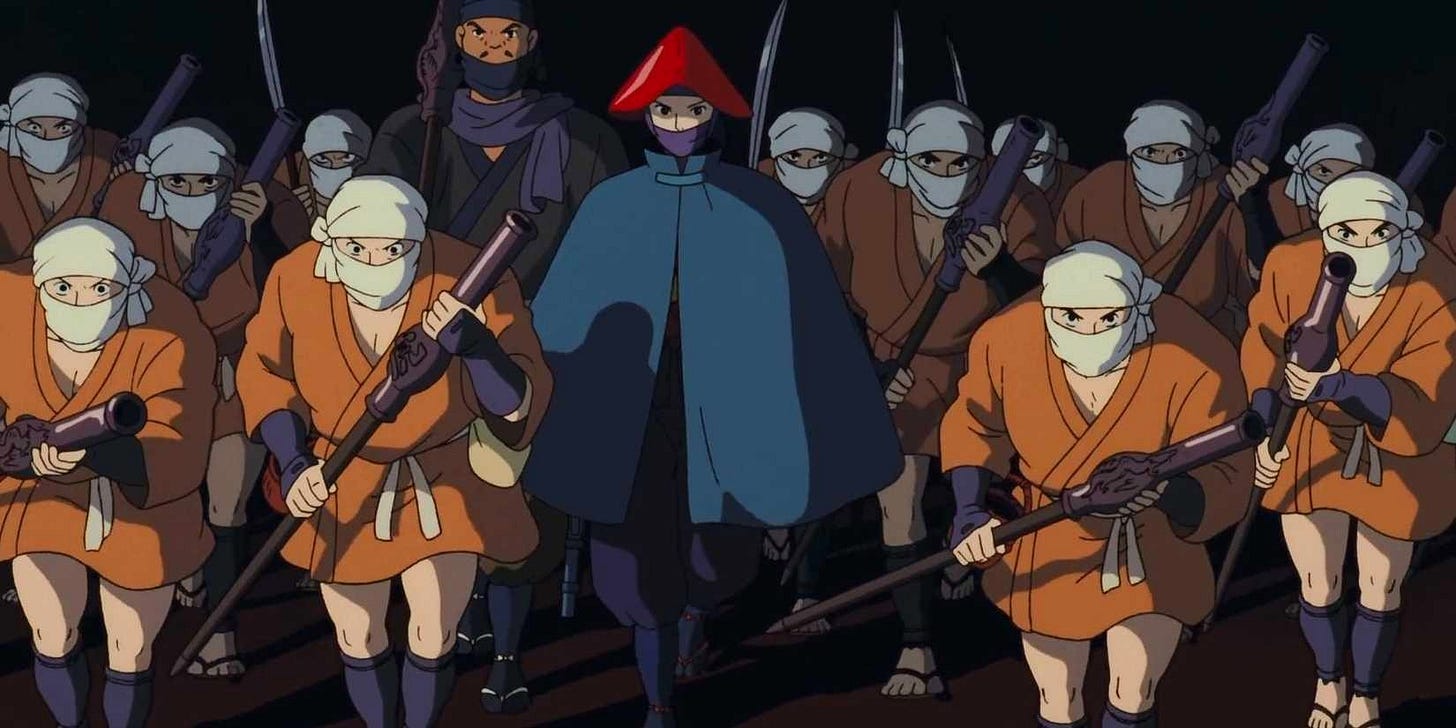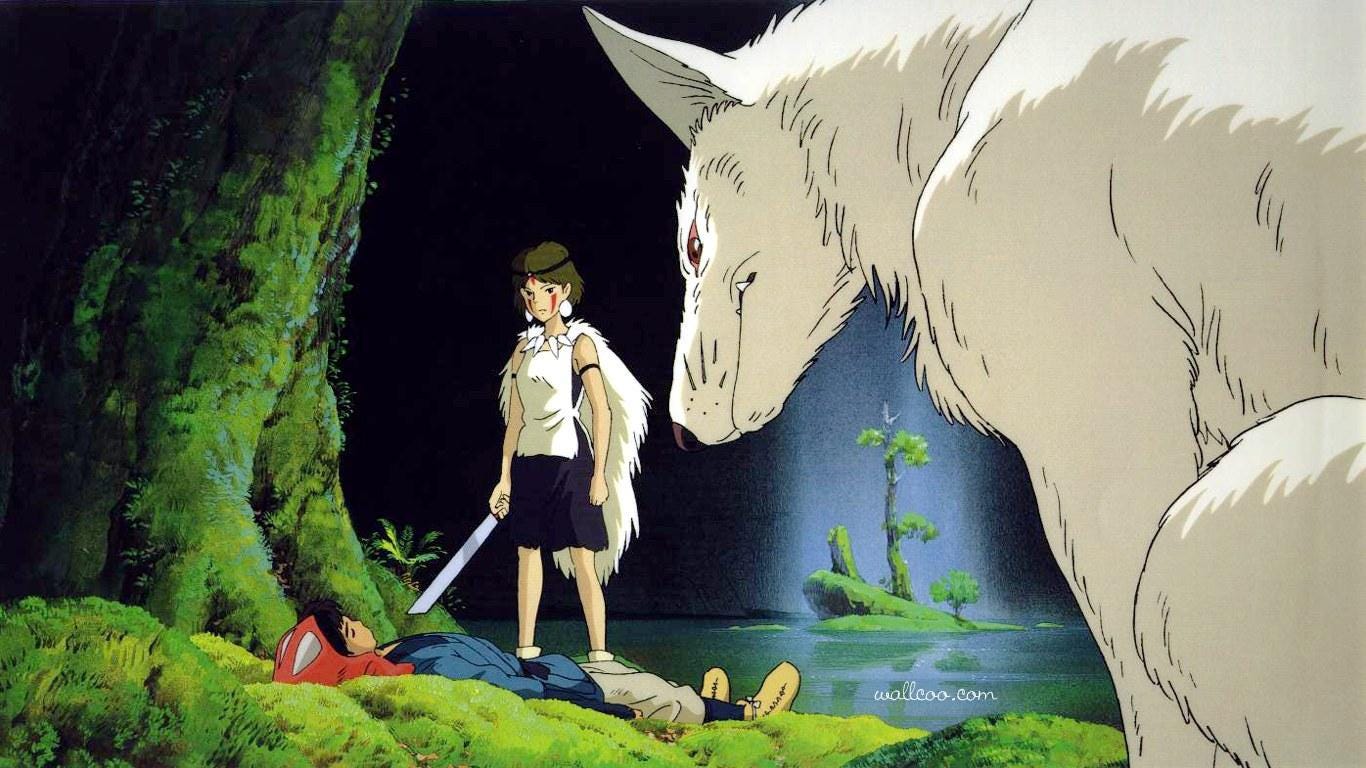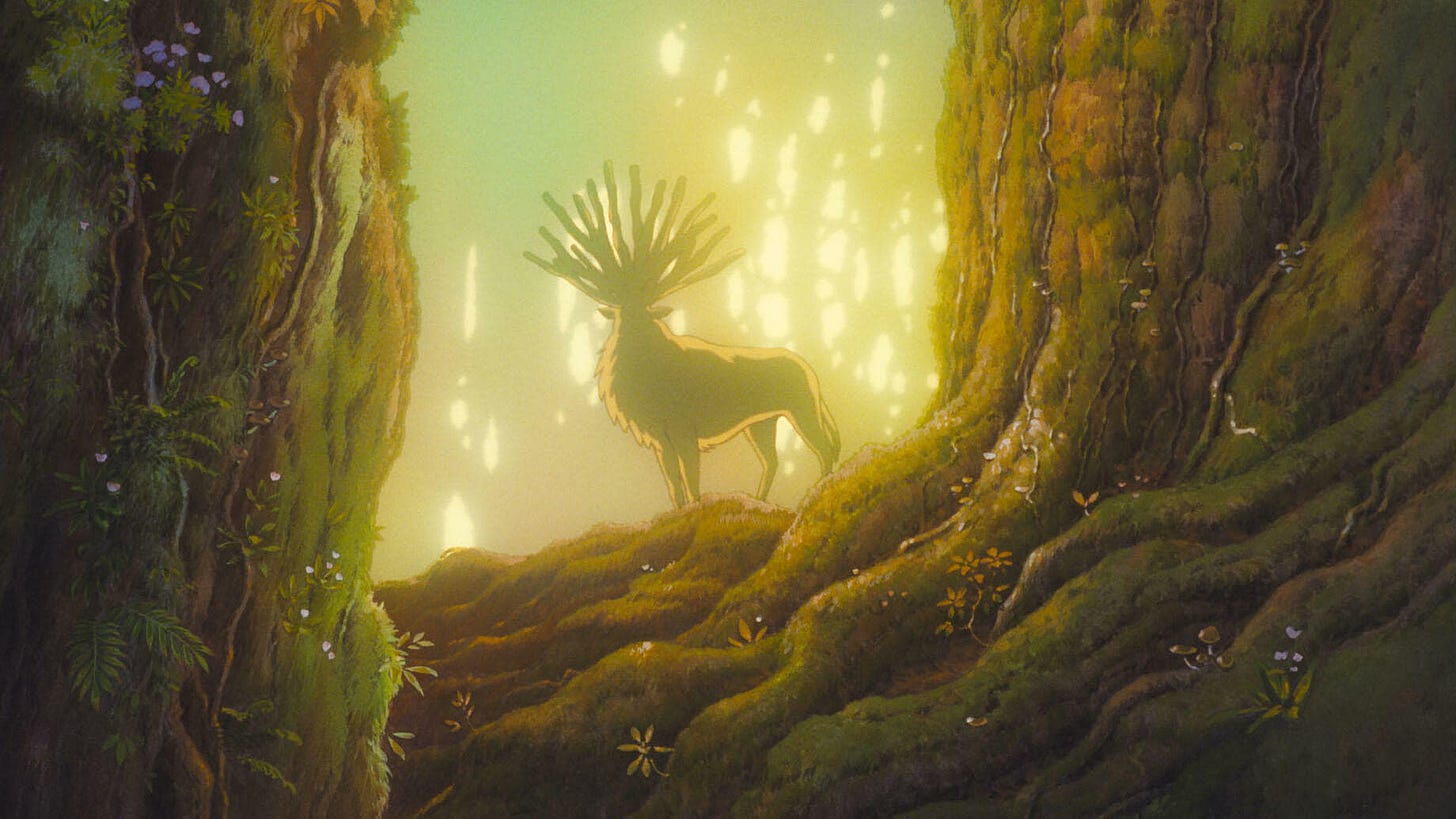Industrialism and Coexistence in Princess Mononoke
What Miyazaki's masterpiece teaches us about the cost of progress—and the hope for balance.
In our post-industrial world, where progress too often comes at a detriment to the natural environment, Hayao Miyazaki offers a transformative meditation on the complex relationship between nature and industrial advancement. Princess Mononoke follows Ashitaka, a young prince from the declining village of Emishi, who contracts a curse of vengeful hatred from a boar God corrupted by a demonic spirit. On the advice of the village’s ‘wise woman’, Ashitaka leaves his home, embarking on an enlightening journey to find the source of the curse and, hopefully, a cure. His travels lead him into the midst of a violent conflict between the humans of Iron Town, an industrial powerhouse led by the ambitious Lady Eboshi, and the inhabitants of the sacred forest, including the titular character, Princess San Mononoke, a human girl raised by the wolf goddess Moro.
Iron Town, a bustling industrial settlement, is built on the exploitation of natural resources, where human ingenuity, spearheaded by the formidable—and vastly innovative—Lady Eboshi, is powered by the mining of iron. The vast settlement is situated on the edge of the sacred forest, home to a host of animal gods, each representing a different characteristic (the apes, defiance; the wolves, loyalty; and the boars, stubbornness). The deliberate positioning of the major industrial town on the outskirts of the sacred forest acts as both a reminder of the closeness of humanity to the natural world and a symbol of the increasing destructive encroachment, in the film’s reality and ours, of the natural world by the human race. One of three main conflicts in the film is between Iron Town, representing humanity, and the animal spirits living in the forest. Miyazaki resorts to Japanese religion and myth, using gods, monsters, and spirits to convey nature’s overlooked autonomy that transcends its instrumentality in human projects. The human destruction of the forest is twofold: it is materialized in Lady Eboshi’s mission to sever the head of the Great Forest Spirit, a deity of life and death, and in the more layered, gradual destruction that is the basis for the industrial progress of Iron Town. The gradual dispossession of the forest strips away the delicate balance between human civilization and the natural world, leading to the displacement of countless creatures who call the forest home. Through its careless exploitation of natural elements, humanity threatens the very existence of their fellow animals and of the resources they seek to profit from, accelerating a cycle of perpetual violence.
Lady Eboshi’s (and Jigo’s) direct effort to attain the head of the Great Forest Spirit is an overt symbol of the will to dominate and control nature—a will achieved through the devaluation of the sacred to a commodity conquered and used for profit. This explicit act of violence contrasts with the implicit, more insidious destruction through industrial expansion—the chopping down of trees, the poisoning of the land—that transpires gradually but continuously, gone unnoticed by those who benefit from it. While Eboshi’s operation is calculated and conscious, the progressive destruction of the forest is systemic, grounded in the machinery of industry and the demands of an industrial feudal society. Both methods, however, expose industry’s (and capital’s) disregard for nature’s intrinsic value, presenting a profound analysis of the types of exploitation that derive from the drive for superficial growth and unsustainable development. On the other hand, Ashikata’s home village, Emishi, is a beacon of peace—its residents live in harmony with their surroundings, relying on a sustainable way of living. The ‘human desire’ for domination and control over nature is therefore not an innate human characteristic, but the inevitable result of a socio-economic system that rewards such practices. Emishi’s decline is not only a reflection of historical evolution but a signal of the seemingly inevitable failure of peaceful naturally occurring coexistence in the face of a large-scale profit-driven economy. The village, once prosperous and full of life, is now gradually withering away as the forces of industrialization take hold of medieval Japan—and humanity at large. The societal transformation that Ashitaka observes is an insight into the way things were (and remain to be in certain similarly declining villages around the world) and how the overexploitation of natural resources manifested itself into the very essence of modern civilization—so much so, that it is now accepted as an intrinsic property of humankind.
The Emishi’s relationship with nature is also spiritual (notably, spirituality was not observed in Iron Town—perhaps because there is little time for spirituality when it is profit that is worshipped). When the cursed boar god, Nago, attacks Emishi, Ashitaka first pleads with him to go home, and after his eventual defeat, the village wise woman’s impulse is to seek guidance and insight from Nago. Having been raised in an environment that reveres the natural world’s spiritual properties, Ashitaka consults with the animal spirits throughout the film for their perspective—something Lady Eboshi is not particularly interested in doing. Suitably, the origin of the boar god’s, and thus Ashitaka’s curse, is the violence that Nago suffered at the hands of Lady Eboshi, who saw him as an obstacle to her objectives. Eboshi goes on to needlessly slaughter the boar tribe in its entirety in a display of domination. In the same battle, Eboshi allows dozens of her soldiers to be killed by her explosives. Here, Lady Eboshi, as the representative of Iron Town and a symbol of an industrial-feudal hybrid society, reflects core aspects of modern capitalism through her predatory industrial project. At its heart, the capitalist system, which thrives on the same exploitation of natural resources observed in Iron Town, inherently values profit over wellbeing. It is then, fitting, that she should allow her soldiers to die in vain, the same way that a profit-driven system, supposedly progressing the human race, prioritizes its ostensible advancement over human life as it does over natural resources, non-human life, and even its own long-term sustainability. The men’s deaths also signify the absurdity of war—the boar tribe is slaughtered, and to that end, Lady Eboshi ‘wins,’ but for the men who died needlessly, there has been no victory at all.
Another central conflict is between good and evil—and where the line blurs between the two. The protagonist, Ashitaka, has been tasked to “see with eyes unclouded by hate.” Like many protagonists in Miyazaki’s work, he serves as a mediator between two oppositional perspectives. The humans of Iron Town, faced with the inability to tame the wild and dangerous force of nature, are guided by despair and self-preservation, just as the animal tribes of the sacred forest are guided by their own survival instincts. Each tribe of the forest also has a personal vendetta against the humans: the ape tribe because they cut down their trees, the wolf tribe because they killed members of their pack, and the boar tribe because they caused the curse that killed their leader, Nago. But all of the forest’s residents are united by their desire to save themselves, the forest, and its life force, personified as the Forest Spirit. Ashitaka recognizes that Iron Town’s inhabitants, and its ruthless leader, are motivated by many of the same impulses as the animal tribes.
As is the standard in Miyazaki’s works, the antagonist, Lady Eboshi, is portrayed as a multifaceted character: despite her apparent ruthlessness, she is a compassionate and responsible leader, dedicated to providing opportunities to marginalized members of society; the women who comprise the workforce in Iron Town were saved from brothels, and her gun-makers are lepers whom she feeds and houses. Furthermore, Lady Eboshi herself is somewhat manipulated by Jigo, a hunter and a Monk working for the Emperor of Japan, who seeks to sever the head of the Great Forest Spirit to exploit its ability to grant life, who is indifferent to the consequences that befall her—“when you’re going to kill a God, let someone else do your dirty work.” The duality of her character provides the viewer with a more nuanced understanding of the moral complexity that exists in us all, indicating to us that she is not just evil (in the same way no one is just one thing), but rather a flawed product of her environment, embodying the ways in which power structures that alienate human beings manipulate both the oppressed and the oppressor, raising questions about the broader implications of industrialization and the moral compromises made in the pursuit of progress. Her character serves as a mirror, reflecting the internal struggles faced by individuals caught in systems that pit survival against ethical considerations. As Ashitaka attempts to navigate this divide, the audience is prompted to reconsider their own roles within societal structures.
At the film’s climax, Lady Eboshi succeeds in decapitating the Forest Spirit, a deity of life and death, in a bid to secure its head as a prize for power. However, this unleashes catastrophic consequences: the Forest Spirit’s body transforms into a destructive mass, seemingly vengeful in its search for its missing head, spreading a toxic flood that engulfs Iron Town, and setting the forest ablaze. In the end, Ashitaka and San, despite their conflicting loyalties, manage to work together to return the Forest Spirit’s head, upon which its restored body collapses across the landscape, endowing a revitalizing breath to the scarred earth. The floods and fire dissipate, and the Earth takes over, transforming Iron Town’s ruins into a lush green hill. Though the forest and its gods are forever changed, their sacrifice allows for new growth, signaling the possibility of renewal and coexistence amidst destruction. In the film, it is human empathy and understanding, represented by Ashitaka and San, that overcomes the failure of humankind to acknowledge and respect natural boundaries. Ashitaka is the only one who can see hatred for what it is: a futile and dangerous pursuit.“Look, everyone! This is what hatred looks like! This is what it does when it catches hold of you! It’s eating me alive, and very soon now it will kill me! Fear and anger only make it grow faster!” Ashitaka’s ability to “see with eyes unclouded by hate” is not the product of some divine order. But it is not through willpower alone. It is his upbringing and environment that allows him to do so with determination. Therefore, it is senseless to judge those unable to do so. Instead, the film promotes understanding as a pillar of coexistence.
Princess Mononoke is a warning of what transpires when humankind becomes entirely disconnected from the natural world by which it was made. This disconnection is the precedent for the exploitation and destruction that follows. When humanity falls out of touch with the world around them, its expressions are unseen: temperature rises become numbers, polluted rivers become unremarkable, the losses of species distant afterthought. This detachment justifies exploitation by reduces the living world to mere abstractions—no longer must we endure the summer heat or navigate its challenges firsthand. As Moro, the wolf goddess, tells Ashikata, “the trees cry out as they die, but (humans) cannot hear them.” As if we are some external force and not nature itself, we do not adapt or acclimate, we do not migrate when the weather is unbearable, as all living beings do. Our interdependence with nature is forgotten, and so is its value outside of our benefit. Miyazaki advocates not for rigid environmentalism but for a rekindled love and respect for the natural environment in which we live, and for a heightened understanding and acknowledgment of its agency and integrity. The film also frequently reminds us that nature’s beauty is not only tranquil and idyllic, but oftentimes brutal and violent, and should be respected nonetheless.
The ending of the film is intentionally open to interpretation; when the Great Forest Spirit’s head is returned, it regains its natural form and falls into the Earth, restoring the natural balance. The scene is tranquil; flowers and grass grow where Iron Town once was, and its residents watch in amazement. But the land has been transformed: “After (the Forest Spirit’s) head was returned, nature regenerated. But it has become a tame, non-frightening forest of the kind that we are accustomed to seeing.” For Miyazaki, human civilization and the natural world are irreconcilable, a divide resulting from our evolution that cannot be conclusively rectified. Additionally, when the Forest Spirit falls into the ground, it seems to disappear. San believes that the Forest Spirit is dead, but Ashitaka offers a different perspective: “Never. The Forest Spirit is life itself.” Whether the spirit is dead or not is not necessarily the point—the gods and spirits may be gone, but it is now the responsibility of the human race to listen to the natural world and give it a voice. “It’s not like we can coexist with nature as long as we live humbly, and we destroy it because we become greedy.” It is thus our responsibility not only to give nature a voice but to advocate for its protection in the face of corporate greed. This is both because nature has inherent value and because it is our home: “The environment is where we all meet, where we all have mutual interest; it is the one thing all of us share.” In Mizayaki’s vision, humanity disrupts the natural order (and detriments itself in doing so) when we fail to acknowledge our propensity for wrongdoing. We can, however, restore harmony by learning to shift our perspectives and learning to speak for nature. We can do so by creating a society that honors nature’s dignity and recognizes the destructive capacities of commercialization and exploitation. It is also vital that we retain spirituality as a standard practice for its understanding that the world from which we came should be revered in all its forms. For our civilization to truly advance, we must prioritize coexistence with the life that surrounds us, for everyone’s sake.







